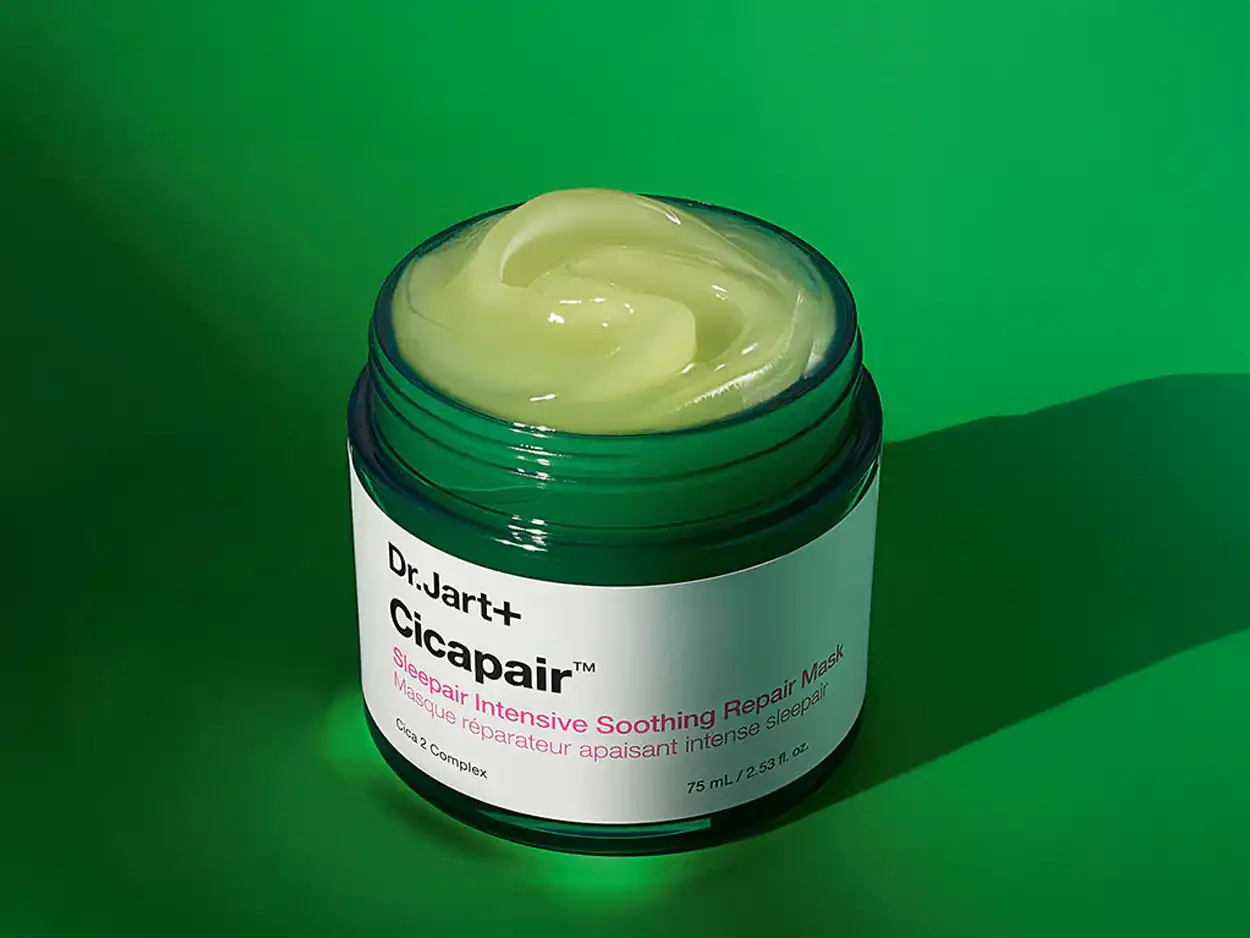Dr.Jart+ is one of those Korean skincare houses that often sparks cult followings with its clever packaging and skin science flair yet it can still slip under the radar for anyone lost in the glow-tonic aisle. From its playful rubber masks to the fan-favorite Cicapair line the brand knows how to make skin care feel less clinical and more fun.
Enter the mouthful that is Cicapair Sleepair Intensive Soothing Repair Mask, a name that sounds like it crammed an entire bedtime routine into one jar. According to Dr.Jart+ this lightweight gel is meant to act like an overnight spa session, calming redness, reinforcing the barrier and generally sending you to breakfast with smoother brighter skin. Centella Asiatica peptides and allantoin headline the formula while the occlusive texture is billed as slugging-friendly.
I slathered it on every night for two full weeks, swapping out my usual night cream to see whether the promises held up and if the price tag made sense.
This is not a paid or sponsored review, all observations come from my own testing. Skincare is personal so your results may vary.
What Is Cicapair Sleepair Intensive Soothing Repair Mask?
This product is a leave-on gel mask designed to replace a traditional night cream. You apply it as the final step in your evening routine, let it sit while you sleep and rinse any residue in the morning. In skin care terms that places it in the overnight treatment category, a segment that aims to work with the body’s natural repair window between bedtime and sunrise. Overnight formulas tend to carry a higher concentration of soothing or barrier-supporting ingredients than a daytime lotion since they are protected from UV light and makeup during those hours.
In this case the focus is on calming redness and reinforcing the skin barrier. Dr.Jart+ leans on Centella Asiatica extracts for their anti-inflammatory reputation, backs them with a peptide complex it calls R-Protector and adds allantoin for extra barrier comfort. The texture is slightly occlusive which makes it suitable for anyone who likes the slugging method of sealing in moisture but prefers a lighter feel than straight petrolatum. It is dermatologist tested and marketed as safe for sensitive skin although it is still a cosmetic product, not a prescription.
Think of it as a one-step night pack rather than a wash-off mask. The claim is that you will wake up to skin that looks less red, feels better hydrated and shows a smoother surface without having to layer multiple serums or oils before bed.
Did It Work?
In the name of science I benched my regular overnight cream for the full two weeks and even gave it a three night cool off period before starting the mask to keep things pristine and data driven, or at least as data driven as a bathroom vanity can get. Fourteen nights feels like a solid stretch for judging a leave on treatment so I committed to a pea sized dollop on slightly damp skin as the very last step after cleanser and a lightweight hydrating serum.
Night one was all pleasant slip. The gel spread easily, set within a minute and left a dewy seal that never crossed into greasy. By morning my skin felt plump with no tight patches around the nostrils which is where dehydration usually shows up first for me. Redness along my cheeks looked marginally toned down but I chalked that up to eight hours of horizontal rest rather than miracles.
By the end of the first week the hydration story held steady. I did not experience any clogged pores or surprise breakouts, a relief given the dimethicone heavy base. What surprised me was how comfortably it layered over active ingredients on retinoid nights. No stinging, no weird pilling, just a cushioned finish that seemed to buffer irritation. Still, the promised overnight glow was more a soft sheen than any dramatic glass skin moment.
Week two is when I paid closer attention to redness. I have a persistent flush that spikes after hot showers and while the mask muted the pink within twenty minutes of application, the effect never quite lasted to breakfast. My skin looked calmer on waking but not markedly different from the nights I rely on a basic ceramide cream.
Texture wise I noticed a slight smoothing of my forehead where fine dehydration lines usually collect. It was the kind of difference you only spot in bright bathroom lighting yet it convinced me that the barrier support claims have some merit. The catch is that the result plateaued around day ten. Continued use kept the status quo rather than compounding benefits.
So did it work? Partially. It definitely hydrates and it keeps minor redness in check for a few hours, plus it plays well with actives which earns it points. What it did not do is outperform a simpler moisturizer enough to justify a permanent slot in my lineup. Nice to have, not need to have so I will finish the jar but probably will not repurchase.
Main Ingredients Explained
The backbone of this mask is Centella Asiatica in three forms — leaf extract, asiaticoside and the acids madecassic and asiatic. Together they are celebrated for dialing down visible redness and coaxing along barrier repair. If your skin flares up after exfoliation or retinoids, these molecules behave like a fire blanket that lets inflammation cool overnight.
Next comes the trademarked R-Protector peptide complex, anchored by palmitoyl tripeptide-8. Peptides are short chains of amino acids that signal skin to fortify itself. In practice that means a mild bump in resilience rather than a collagen miracle, yet over two or three weeks they can subtly soften that papery look dehydration lines love to exaggerate.
Niacinamide sits high on the list at a barrier-friendly 5 % to 6 % concentration. The ingredient is a multitasker: it smooths texture, tempers blotchiness and reinforces ceramide production so water stays where it belongs. Because the mask is left on for eight hours, even tolerant skin types may feel a momentary tingle on first use but it settles fast.
The formula swims in a sea of lightweight silicones such as caprylyl methicone, vinyl dimethicone and dimethiconol. These create the breathable occlusive layer that makes the product slugging-compatible while still rinsing clean in the morning. Silicones are generally rated non-comedogenic yet cocoa extract scores a 3 on the comedogenic scale. That means very clog-prone skin could see a few closed comedones, which are tiny bumps that form when oil and dead cells get trapped in a pore.
Allantoin rounds out the soothing squad by nudging along cell turnover in a gentle, no-sting way. Glycerin, propanediol and trehalose supply water-binding support so the barrier stays hydrated long after the first dab. The absence of fragrance is a plus for reactive skin, though the presence of synthetic dyes Blue 1 and Yellow 5 might annoy purists.
No animal-derived ingredients appear on the INCI, so vegetarians and most vegans should feel comfortable, but the brand has not provided official vegan certification. As for pregnancy, the formula avoids retinoids, salicylic acid and strong exfoliants, yet niacinamide and synthetic colorants still warrant a quick check-in with your doctor. When hormones are in flux err on the side of caution with any leave-on treatment.
Worth noting: the pH lands around 6, which matches the skin’s natural window, and the product is free of drying alcohols. Those two details help explain why it layers so politely over actives and why I never woke up to that tight, parched feel some gel masks leave behind.
What I Liked/Didn’t Like
Here is the quick tally after two weeks with the green gel.
What Works Well:
- Consistent overnight hydration that leaves skin comfortably bouncy by morning
- Centella and peptide mix takes the edge off post-retinoid irritation without pilling or stinging
- Light silicone veil mimics slugging yet rinses away clean so pillows stay mess free
What to Consider:
- Redness relief fades by breakfast so anyone with chronic flushing may want stronger support
- Results level off after about ten days meaning it functions more as maintenance than a game changer
- Price sits above a standard ceramide cream which may feel steep for incremental benefits
My Final Thoughts
After fourteen nights side by side with my pillow the Cicapair Sleepair Intensive Soothing Repair Mask lands in the solidly good but not life altering category. At 7/10 it performs the essential duties of an overnight treatment: it locks moisture in, keeps minor redness relatively quiet and behaves politely with stronger actives. If your skin is temperamental, you dislike heavy slugging layers yet crave a cushion between retinoid sting and cotton sheets this will feel like a welcome nightcap. On the flip side anyone hunting for a dramatic tone correction or a next morning glass skin selfie may judge the results too subtle for the price.
Because I have played the field with more night creams than dating apps would allow, I feel confident saying this jar earns a friendly nod rather than a standing ovation. I would recommend it to friends whose skin runs sensitive and dehydrated, particularly those wanting a silicone veil that does not suffocate pores. I would steer oil slick complexions or budget purists toward lighter or less spendy options.
If you are shopping around, a few alternatives I have used and rate highly deserve mention. Nocturnal Revive Cream by Deascal is a bit of a Swiss army knife: plumps, soothes and firms without leaning too rich and it does so at a wallet friendlier ticket. LANEIGE Water Sleeping Mask stays iconic for a reason with its airy texture that drenches all skin types in overnight hydration. BIOSSANCE Squalane + Ectoin Overnight Rescue is brilliant for barrier repair nights when windburn or over exfoliation strike. For those wanting a measured dose of vitamin A, Medik8 Intelligent Retinol Smoothing Night Cream offers a gentle retinol bump wrapped in nourishing ceramides.
The usual housekeeping before you dive in: patch test behind the ear or along the jaw and give it 24 hours, sorry to sound like an overprotective parent. Remember too that any glow you coax out of a jar will fade if you ghost your routine so consistency is the real secret sauce.

